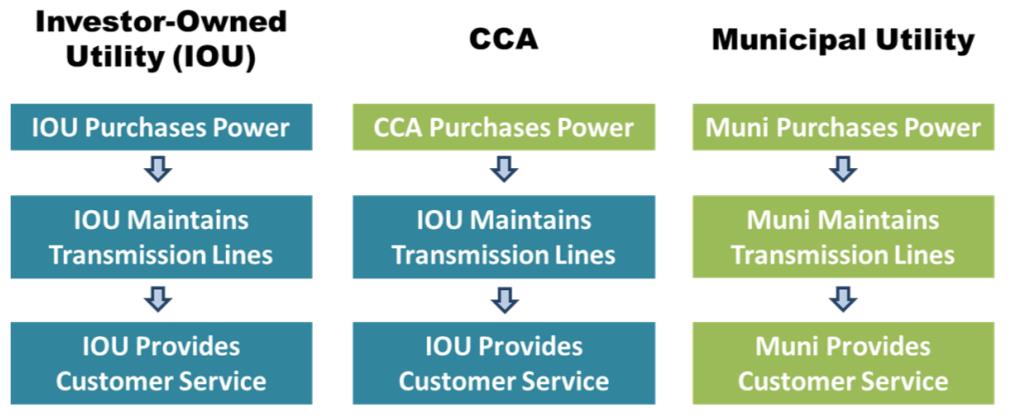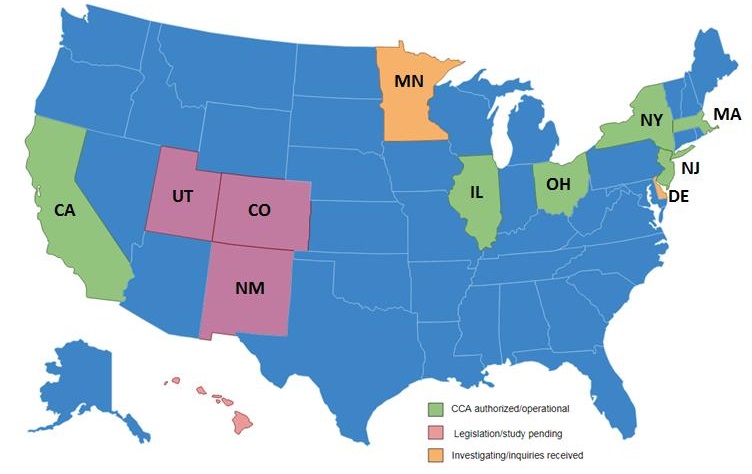Community Choice Aggregation (CCA) Helping Communities Reach Renewable Energy Goals
Sept. 19, 2017 by Benjamin Mow
Community Choice Aggregation (CCA) is becoming a more prevalent method for local communities to source electricity. Under CCA programs, cities and local governments generate or buy electricity, usually from renewable energy sources, based on the needs of their residents.
CCAs are a hybrid between municipal utilities and standard investor-owned utilities (IOU), as depicted in Figure 1. Typically, utilities (whether investor-owned or municipal) are responsible for purchasing and distributing power, grid maintenance, and customer service. Under a CCA program, the CCA, which is administered by the local government, purchases the power, while the incumbent IOU maintains the grid and provides customer service. Because the local government is involved in some of the standard utility functions, the CCA could be considered a middle ground between an IOU and a municipal utility.
Figure 1. Community Choice Aggregation Structure
 Graphic adapted from Local Energy Aggregation Network[/caption]
Graphic adapted from Local Energy Aggregation Network[/caption]
As of 2017, seven states (Massachusetts, Ohio, California, New Jersey, Illinois, New York, and Rhode Island) have passed legislation enabling communities to form CCA programs and another six are exploring CCA options (see Figure 2). In 2015, CCA programs in the United States sold 7.4 million megawatt hours (MWh) of renewable energy to 1.9 million customers. California has the fastest growing CCA market, with 29% participant growth between 2014 and 2015.
Figure 2. Overview of State CCA Legislation
 Graphic adapted from www.leanenergyus.org[/caption]
Graphic adapted from www.leanenergyus.org[/caption]
While states must pass legislation allowing for the formation of CCAs, individual CCA programs are developed at the local level. All states with CCA enabling legislation have deregulated electricity markets*, with the exception of California which has more nuanced electricity market legislation. Having at least a partially deregulated state electricity market is a prerequisite for CCA program development. Policies are adopted by the local government to provide a framework for the local CCA, often designed to be flexible and community-oriented. CCA programs are typically structured such that customers located within the service area are automatically enrolled in program, but can elect to opt-out. Opt-out policies tend to promote higher participation rates. CCA policies are generally developed to meet community goals, including supporting renewable energy development, improving energy efficiency, providing competitive electricity prices, and reducing greenhouse gas emissions.
CCAs usually offer customers multiple purchasing options with different levels of renewable electricity. For example, San Francisco residents can choose between the “Green” package, in which 40% of the electricity is sourced from renewables, and the “SuperGreen” package, which sources 100% of electricity from renewables. The Green package’s electricity rate is slightly lower than the rate of Pacific Gas and Electric (PG&E), the local IOU. The SuperGreen package is sold at a $0.02/kilowatt-hour (kWh) premium over the Green package rate. Most CCAs around the country have similar packages.
CCAs do not completely replace the traditional utilities within their service area. The incumbent IOUs still provide distribution, transmission, and administrative services to customers. The utility retains ownership of the pole and wire infrastructure, as well as handling any line maintenance and power outage issues. IOUs also provide power to customers who opt out of the local CCA.
Cost allocation remains a source of discord between CCA programs and utilities. Utilities are voicing concerns regarding cost shifting between CCA and utility customers, saying that costs associated with grid upkeep are being shifted to customers served by the utility. To help recover these stranded costs, utilities often charge ‘exit fees’ to customers switching to a CCA. CCA advocates claim that this exit fee dis-incentivizes renewable energy production. Inclusive of any exit fee, the default rate class that customers are enrolled in via opt-out policy design is often lower than the local IOU electricity rate. California is currently in the midst of a state-wide discussion regarding cost shifting between CCA and utility customers, with the California Public Utilities Commission considering alternative methodology in determining the amount that CCA customers pay as an exit fee.
With CCA programs providing an opportunity for communities to both source a greater percentage of electricity from renewable generation and supply electricity at lower costs, conversations are likely to continue at the state and local level concerning the development of these programs.
*In deregulated electricity markets, utilities are responsible for electricity distribution, grid maintenance, billing the customers, and acting as the Provider of Last Resort. In regulated electricity markets, utilities are additionally responsible for sourcing the electricity.
Share

